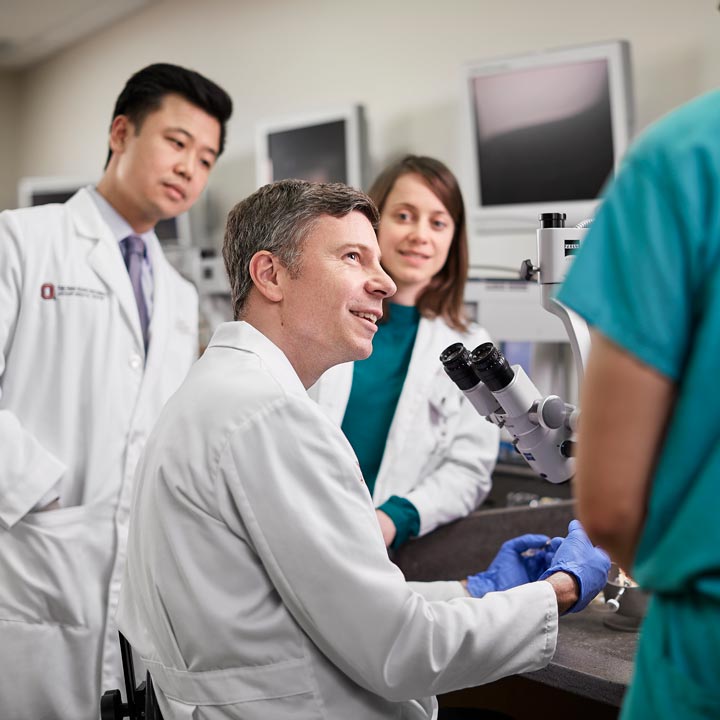 The otolaryngology residency program at The Ohio State University College of Medicine is one of the largest and most successful ear, nose and throat programs in the nation — and is set to expand to teach even more elite surgeons in the coming years.
The otolaryngology residency program at The Ohio State University College of Medicine is one of the largest and most successful ear, nose and throat programs in the nation — and is set to expand to teach even more elite surgeons in the coming years.
“When people are training and going through medical school, they hear from others who speak very fondly of our program,” says James Rocco, MD, PhD, chair of the Department of Otolaryngology – Head and Neck Surgery in the Ohio State College of Medicine. “In addition to our high surgical volume and case complexity, there’s a culture of collegiality with good relationships between residents, faculty and staff. Moreover, Columbus is a nice place to live while going through residency.”
This year marked the first year of having a full roster of 25 residents; the program expanded to a five-resident class in 2018. The current cohort is one of the department’s most diverse groups of residents, both in terms of medical school training and gender diversity. Nearly half of the cohort are women.
“The program has changed every year as we have integrated five residents per class,” says Brad deSilva, MD, residency program director and clinical professor in the Department of Otolaryngology – Head and Neck Surgery at the College of Medicine. “With such a large program, each class has had different schedules each year of their residency training. It’s allowed more specific rotations and more in-depth learning. Residents can learn in community-based models rather than solely in hospital-based sites.”
This success has led to the program’s No. 5 spot in the Doximity residency program rankings, as voted on by physicians across the country.
“We’re fortunate to have a historic presence nationally with our department and residency program that consistently trains skilled surgeons,” Dr. deSilva says. “We also benefit from having our chair and other leaders traveling to national meetings, presenting research and being involved in mentorship. That’s helped us maintain our reputation and ranking over time as medical students see our program as a great place to train.”
One key driver bringing residents to Columbus is the department’s reputation as a high-volume surgical program as well as renowned in all the different ENT subspecialties.
“Residents come out of our program with exceptional operative case numbers and they know how to operate; that’s a very positive thing for them,” Dr. Rocco says. “They also get exposure in all the subspecialties and gain a truer sense of what fits them best. It helps them become well-trained for that next step in their career, whether it be specialty fellowship training or joining a private practice.”
Now, the residency program has received approval from the university’s Graduate Medical Education office to pursue six residents per class. While a lengthy process, if approved by the Accreditation Council for Graduate Medical Education, the Ohio State College of Medicine would be just the third program nationwide with six ENT residents per class.
With even larger residency classes coming in, the program can further expand to create new learning opportunities with specialty rotations like skull-base surgery and sleep surgery, two areas that are growing nationally. With new ambulatory sites opening across the city, residents also have new options for where they can learn and envision practicing in the future.
“Residents can learn in a more specialty-specific rotation schedule where they develop surgical skills quicker in certain areas,” Dr. deSilva says. “With a large, highly involved faculty, residents learn similar techniques from a number of experienced and skilled surgeons. This allows them to incorporate strategies and techniques that work best for them.”
The larger residency class gives greater flexibility for residents to complete research, attend meetings and network for future roles without impacting patient care. It also offers residents a better work/life balance with improved call schedules.
“Generationally, people didn’t think about quality of life when I was training,” Dr. Rocco says. “Now, residency is more balanced. We pay a lot more attention to quality of life and supporting our residents’ well-being. I’m especially impressed with Dr. deSilva’s ability to maintain this balance in our residency training program.”
This growth coincides with growing medical needs in one of the fastest-growing metropolitan areas in the nation.
“Ohio is growing, and projections indicate that we won’t have enough medical care for all that growth,” Dr. Rocco says. “Growing our residency program is an investment for the future.”
